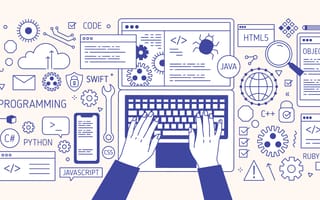The rapid pace at which technology is evolving has increased the need for full-stack developers all over the country.
As a matter of fact, “full-stack engineer” was listed as the fourth fastest-growing job on LinkedIn’s 2020 Emerging Jobs Report with hiring growth of over 35 percent since 2015. Furthermore, industry experts are predicting that the need for full-stack engineers will only increase as companies in all industries continue to migrate to a virtual-work environment due to the ongoing uncertainty of the coronavirus pandemic.
Built In caught up with engineers across the country to gain some insight into what the role of full-stack developer specifically entails at each of their companies (some of which are even hiring right now) and an interesting project they’re currently working on that’s put their skills to the test.
What is a Full Stack Developer?
Opendoor
Eli Badgio
FULL-STACK SOFTWARE ENGINEER

Opendoor is a real estate company that provides people a simple way to buy, sell or trade-in a home. At the company, full-stack developers are expected to work across the stack on all parts of the assigned project, from design to implementation and launch, Full-Stack Software Engineer Eli Badgio said.
What role does a full-stack developer typically play at your company?
At Opendoor, full stack-developers are expected to own projects end to end, across the stack from design all the way to implementation. As part of the partnerships team, I am always working across the stack because we have ownership over an internal back-end service, an external facing GraphQL API consumed by our partners, and a suite of internal and external dashboard web apps.
Several months back we launched a new feature allowing partners to listen to key events regarding any of their customers currently in the Opendoor process via webhook. There were three broad areas of work involved here: adding a new data model for partner application webhooks, adding a new interface in our Developer Dashboard for engineers at partner companies to manage their webhook endpoints, and building out infrastructure for processing our internal Kafka topics on customers' state changes and forwarding these events via webhook to the relevant listeners.
As a full-stack engineer, I was able to work across the stack on all parts of this project, allowing our team to design, implement and launch this new feature to our partners in the span of just a couple of sprints.
It’s been even more rewarding knowing that we are building something our customers will use and love from the moment we launch.”
What’s an interesting project you’re currently working on?
Recently, I have been working on a project aimed at giving our homebuying customers the ability to shop for new construction homes in our mobile and web apps alongside the existing Opendoor homes and MLS listings.
This project involves a considerable amount of cross-team collaboration across multiple surface areas and the entire development stack. In order to get these new home listings in front of our customers, we’ve had to enhance our data infrastructure by adding an entirely new data pipeline for consuming new construction home listings; modifying our buyer app to handle the presentation of a new listing type that has an unusual community plus model listing format; and finally, creating new data models for tracking and managing tour requests scheduled with new construction pre-list homes.
Although this project has been a very fast-paced and challenging one, it’s been highly rewarding having the chance to work end to end on a project that has complexity not only from the engineering side but also from the product and operations side. And, it’s been even more rewarding knowing that we are building something our customers will use and love from the moment we launch.
Instacart
Austin Pivarnik
SENIOR SOFTWARE ENGINEER

At food retail company Instacart, full-stack engineering is all about ownership. Each project presents an opportunity for full-stack engineers to take on as much (or as little) responsibility and ownership as they would like, Senior Software Engineer Austin Pivarnik said.
What role does a full-stack developer typically play at your company?
Beyond coding, full-stack developers play an ownership role. I always tell interviewees and new hires that the role at Instacart is what you make it. Each project presents an opportunity for you to take on as much (or as little) responsibility and ownership as you would like. As part of the emerging products team at Instacart, I’ve had the opportunity to not only ship interesting features but also fly to our retailer partners to lead cross-company engineering on-sites, demonstrations for their technical leadership and end-to-end test product launches.
Additionally, full-stack developers at Instacart have a wide breadth of technical knowledge across the stack with an “inner T” of depth into a particular focus area. I feel there’s a common misconception that full-stack developers are expected to code an entire feature from end to end on their own. In reality, full-stack engineers at Instacart often alternate between front-end and back-end features on a per-project basis, as the depth of knowledge and personal interest align. In this way, they often make meaningful observations on our stack and workflows and where they may be able to be improved. This valuable insight guides our architectural direction.
Full-stack engineers at Instacart often alternate between front-end and back-end features on a per-project basis.”
What’s an interesting project you’re currently working on?
One feature we’ve just wrapped up is “Certified Delivery,” which allows a customer to verify their identity upon delivery with their smartphone. This feature gives both shoppers and customers an easier way to confirm the delivery of high-value items. This feature required close cross-functional coordination with our fulfillment team, orchestrating cross-service remote procedure calls (RPC) and push notifications between our shopper and customer applications at the time of delivery.
It’s rewarding to try out features you’ve built in the wild. I still get excited each time I go to my local Publix and see the “online pickup” section of their deli filled with sub sandwiches labeled “Instacart.” Behind that short string of text was a many-months-long project of integrating Instacart with Publix’s order management system, as well as Instacart’s first foray into customizable prepared food options.
Benchling
Lily Zhang
SOFTWARE ENGINEER
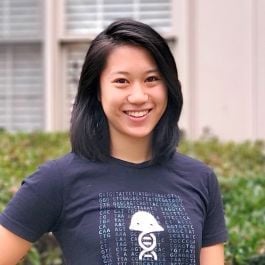
Benchling is a SaaS-based platform built specifically for life sciences and research and development. Software Engineer Lily Zhang said that she enjoys the fact that full-stack engineers at Benchling have many opportunities to collaborate with people outside of just their specific team and function.
What role does a full-stack developer typically play at your company?
Benchling is a very ambitious company, and we often have more projects we want to tackle than we have engineers to tackle them. Therefore, it’s important that our engineers are product-focused. Being full stack empowers them to implement an entire feature end to end, whether it’s designing the data models or building out a complex UI.
With the capability management project, the work wasn’t always evenly distributed across the stack. Because my teammates and I all work across the stack, we were able to be flexible sprint to sprint and focus on the areas that required the most attention. This helped push us across the finish line faster than if we each only worked on one piece.
Working across the stack also gave us the opportunity to collaborate with coworkers outside of our team and function, whether that’s with the project manager or designer to answer front-end UX questions, or with other engineers to brainstorm solutions for a back-end interface for other teams. I’ve really appreciated the opportunity to do full-stack development at Benchling and it has helped me to become a stronger engineer.
It’s important that our engineers are product-focused. Being full stack empowers them to implement an entire feature end to end.”
What’s an interesting project you’re currently working on?
The Benchling platform consists of many different applications. Currently, once an application is enabled for a customer, all users have access to it. Since joining Benchling in June, I have been working on the capability management project, which gives customer administrators fine-grained control over which users and user groups have access to each application. This is critical for both complying with regulatory standards and driving enterprise adoption.
I have faced a few challenges working on this project. First, the project started months before I joined, so I had to rapidly gain context on decisions that were made before I was around. This was made trickier by the fact that this project touches every single application in our product, so it additionally required a breadth of understanding. Finally, I had very little front-end development experience, so that was another axis along which I had to learn quickly.
However, the challenges were worth it. I feel much more confident in my full-stack development skills, and I’ve gotten to work with some really amazing and smart engineers along the way (shoutout to Ben, Rachel, and Steven!). Also, this project has finally landed in the hands of our first customer, Genentech, and we plan on rolling it out to more customers in the coming months. There’s nothing more rewarding than knowing that real people are using something that I’ve worked hard on, and I’m excited to continue working on projects like this in the future.
Grammarly
Kendal Cockrel
FULL-STACK SOFTWARE ENGINEER

Grammarly offers a digital writing assistant that helps 30 million people daily write more clearly and effectively. At Grammarly, it’s important for full-stack engineers to be adaptable in order to jump into any part of the stack so that customers can be quickly supported, Full-Stack Software Engineer Kendal Cockrel said.
What role does a full-stack developer typically play at your company?
There are quite a few full-stack engineers at Grammarly, and like every other developer, we work closely with other engineers to ship the latest features. However, full-stack engineers have the added bonus of flexibility. With this flexibility comes the need to be adaptable — to be able to go where needed so that as a team we can continue to move quickly and support our customers.
This means that on one project, a full-stack developer may be responsible for writing specs and building out a new scalable web service. On their next, they might be tasked with working with a designer to bring an elegant, user-friendly UI to life. Depending on size and scope, they may also see an entire feature end to end, doing everything from designing the database schema to rendering that data on a new webpage they’ve built themselves. No matter the project, full-stack engineers at Grammarly are excited to work on a full spectrum of projects. While we mainly build services in Java, React and TypeScript, we quickly adapt to different languages and scenarios to make sure we’re always delivering a high-quality product to our users.
No matter the project, full-stack engineers at Grammarly are excited to work on a full spectrum of projects.”
What’s an interesting project you’re currently working on?
Currently, I’m working on expanding Grammarly’s business website. We want to give the site a refresh and allow for marketing content to be added and updated without requiring engineering to make those changes. It’s one of those projects that has both a server-side and client-side component, which is the bread and butter of full-stack development. Most of the front-end work will be done in React and TypeScript. React is what got me excited to dive more deeply into front-end work in the first place, so I’m excited to be working with it again after doing mostly Java development in the last few weeks.
One of the challenges is working with our existing content management system and dabbling into unfamiliar code. Some of its legacy code is written in — gasp — PHP. Still, it’s another opportunity to learn by doing, which is something I’m a big fan of. And of course, there’s also the added bonus of empowering our marketing team to be able to showcase all of the exciting features we’re building for Grammarly Business. Allowing them to be able to do this easily, without needing help from engineers, is a reward of its own!
Vungle
Kevin Chiang
SENIOR SOFTWARE ENGINEER

Adtech company Vungle partners with mobile app developers to monetize their apps through innovative in-app ad experiences. As a full-stack developer, Kevin Chiang said that his responsibility encompasses everything from UI styling and logic to developing servers and databases for website functionality.
What role does a full-stack developer typically play at your company?
The San Francisco-based applications team is responsible for managing our advertiser self-serve and admin platforms. As a full-stack developer, my responsibility encompasses everything from implementing UI styling and logic to developing servers and databases for website functionality.
A recent project that our team has built is the campaign multi-bidding feature. On the front end, we’ve created editable tables for our users to easily view and edit campaign bids. On the back end, we’ve built multi-bidding API endpoints, which are responsible for updating the bid values in our database. Most of our team members work across the stack, and we’ve been able to take advantage of this skill set on multiple projects.
Most of our team members work across the stack, and we’ve been able to take advantage of this skill set on multiple projects.”
What’s an interesting project you’re currently working on?
I am currently working on Vungle’s advertiser API, which allows customers to review their campaign data as well as edit various settings within Vungle’s ad network. This project is essential to supporting our customers when generating competitive pricing models and bids in order to scale their campaigns. It’s especially rewarding that we are able to provide this tool and be a trusted guide for our customers to advertise with us.
Sendoso
Ana Medrano Fernandez
SOFTWARE ENGINEER

Marketing technology company Sendoso is a sending platform that helps companies engage with their buyers and customers. Software Engineer Ana Medrano Fernandez said that on most projects, one full-stack engineer will take on most of the responsibilities and the others provide support with different tasks as needed.
What role does a full stack developer typically play at your company?
Sendoso is a fast-growing startup with ambitious goals, so we are moving quickly. Having full-stack engineers gives us many utility players who can tackle the challenges at hand. For members of the team, this translates to being able to own large parts of projects and having exposure to different parts of the codebase.
Engineers build and maintain code, but at Sendoso we can really own our work. A recent example is how our team all worked together to allow our customers to set expiration dates on the digital gifts they send and to communicate those dates more effectively with the gift recipients. One engineer took on most of the responsibilities — working on data migrations, updating models, running jobs to update existing data, etc. — and the rest of the team provided support with different tasks as needed. I worked on updating the email copy to clearly communicate the new expiration dates.
It’s exciting to have full ownership over our projects and the trust of the rest of the company to influence the product we’re building.
Having full-stack engineers gives us many utility players who can tackle the challenges at hand.”
What’s an interesting project you’re currently working on?
Currently, we are working on a really exciting redesign that will impact the customer UI. While this project focuses on the front-end user interaction with Sendoso, it requires changes throughout the code stack. For example, building a new filtering functionality required introducing new relationships into the database and updating API responses in addition to the front-end changes. Because we are working on a redesign in parallel with supporting the existing workflow, our work might inadvertently cause regressions to our existing functionality. To protect against this, tests are critical to establishing confidence in our changes as we work. Testing in itself is a challenge — sometimes building a good test can be just as hard as building the task it’s trying to test.
As a full-stack developer, I design the model and its relationships, API routes and responses, and the front-end functionality that our users ultimately interact with. A big challenge is balancing the trade-offs across the code’s performance, complexity and development speed. The most rewarding part is when you get the balance just right.
Vestwell
Raghava Kamalesh
SOFTWARE ENGINEER

Fintech company Vestwell offers a modernized solution to retirement offerings by creating an easy-to-use digital platform to offer and administer 401(k) plans. Software Engineer Raghava Kamalesh said that being a full-stack developer at Vestwell has allowed him to take ownership of his projects in order to increase efficiency.
What role does a full-stack developer typically play at your company?
Full-stack developers are very valuable at Vestwell. While the platform is very back end-heavy, we have four client user types and most projects have a front-end component. Being a full-stack developer is mutually beneficial, for the company and myself, because efficiency is increased and I am able to command more ownership of my projects. Because I was able to vertically own my recent loans project across the stack, I was empowered to design and build these features independently. This independence leads to efficiency, as I designed and built the back-end service and related APIs and subsequently consumed the same APIs on the front-end components of the project.
I enjoy full-stack work, and it’s certainly been rewarding from a technical standpoint.”
What’s an interesting project you’re currently working on?
Recently, I have been working on a project that adds the capability for Vestwell users to request a loan from their 401(k) savings and automatically pay that loan back over time. We’ve also added the functionality for users to pay the entire loan back at once at any given point while their loan is live. It’s been a challenging project because there is a lot of record-keeping that needs to be done correctly: a loan amortization schedule needs to be created, user investments need to be sold and ultimately, these investments need to be repurchased as the user makes their repayments.
There’s a good deal of back-end work, but also front-end work as the user needs to request, agree to and pay back the loan. I enjoy full-stack work, and it’s certainly been rewarding from a technical standpoint, but it also feels like a timely project given the current state of the world. No one wants to take a loan from their 401(k), but people need to, now more than ever. Recent legislation, such as the CARES Act, directly impacts the work we do. There’s a real incentive to make the process of requesting and paying back a loan as simple as possible for our users.
Betterment
Alex Hint
SOFTWARE ENGINEER

Betterment is a financial technology company that offers users everyday cash management, online retirement advice and investing tools. Working at Betterment has allowed Software Engineer Alex Hint to expand his role beyond coding, code reviews and engineering mentorship to more product-related work.
What role does a full-stack developer typically play at your company?
As a full-stack developer, my role at Betterment has evolved in the past three and a half years. The theme of the role has stayed the same: alignment. My manager and I have prioritized aligning my skills, goals and interests with the right opportunities.
My primary focus has been on back-end technologies, however, my interest was in front-end development. I was able to align my interest by leading accessibility efforts, being part of an internal style library-development team and joining our React and TypeScript group. On the last two projects that I’ve worked on, I led the front-end efforts and built out complex user flows in React and TypeScript.
Currently, my role entails more than just coding, code reviews and engineering mentorship. After expressing an interest in more product-related work, I was given the opportunity to lead the new fraud prevention project. This project spans across multiple engineering teams and requires strong planning and cross-functional communication. I really enjoy the complexity of problems we encounter and the solutions my team comes up with.
I really enjoy the complexity of problems we encounter and the solutions my team comes up with.”
What’s an interesting project you’re currently working on?
At Betterment, we deal with people’s finances. The security of this data plays an enormous role in building trust in our platform and brand. Currently, we are working on revamping the signup and KYC (know your customer) experiences. We’re focused on making the user experience intuitive and delightful while making sure we prevent fraudsters from signing up.
I’m leading our fraud prevention efforts. The project involves an integration with a new digital ID verification vendor, cross-team collaboration and project management. Our goal is to detect and prevent fraud before it can happen in our system. One of the challenges we face is coordination between multiple squads, which we tackle by building out our integrations behind feature flags.
We dark deploy our code and only turn it on when the project is ready to be released. We break down this multiple months-long project into milestones, so we’re able to ship minimally-viable products (MVPs) that we can learn from and iterate on. As we complete each milestone, we feel a sense of accomplishment. With the release of our first MVP, we’ve seen a major drop off in signups of bad actors. After this big win, we got nicknamed Fraudbusters, a riff on Ghostbusters.
Skillshare
Sara Gottlieb
DIRECTOR OF ENGINEERING
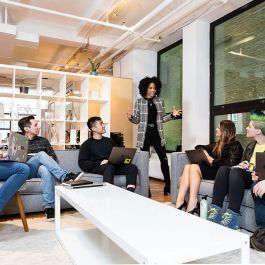
Skillshare is an online learning community offering thousands of classes on topics including illustration, design, photography, video, freelancing and more. At Skillshare, engineers are evenly separated into pods with an equal number of back-end and front-end engineers and one or more full-stack engineers, Director of Engineering Sara Gottlieb said.
What role does a full-stack developer typically play at your company?
Within our engineering team, we have people separated into pods. Engineers on the product side are organized into pods depending on which product they are working on.
The pods tend to be evenly distributed with an equal number of back-end and front-end engineers, with one or more full-stack engineers also within the group. When organizing groups of engineers within a product pod, it’s important to even out the distribution across the stack to ensure that our product features are being built out properly. There are so many ways to approach building out features, and if your team is heavily weighted in one direction, you’ll tend to get things built to that expertise and not necessarily in the most efficient way. Full-stack engineers help us keep that balance so we approach problems in a full-stack way.
Our growth pod jumps out to me as a great example of full-stack work. On this pod, the roadmap is experiment-driven. This pod tends to have great knowledge of our whole product and user lifecycle, but also comfort contributing in all parts of our stack. We rely on their expertise to quickly build out experiments so we can strive to be data-driven in making decisions that impact our users.
Full-stack engineers help us keep that balance so we approach problems in a full-stack way.”
What’s an interesting project you’re currently working on?
As we look toward 2021, I’ve been working on seeing how we can continue to foster a collaborative working environment while working more asynchronously. We also are thinking about how we can support new hires in onboarding since we’re not all together. This project has encouraged us to look into pair programming tools, taking classes together using tools like Egghead and Skillshare(!), and being more thoughtful and efficient when we do have overlapping times and meetings.
It’s always great to take steps back and throw away all assumptions when looking at current problems. I really enjoy this type of problem-solving with my coworkers, both enabling a supportive work environment, while also improving our processes continually.
CB Insights
Ahmed Hashim
SENIOR SOFTWARE ENGINEER

CB Insights fuses machine learning, algorithms, data and visualizations together to help large enterprises ask, answer and articulate compelling answers to difficult questions. At CB Insights, developers work collaboratively with designers, which results in a quicker feedback loop and allows each team to see things from a different perspective, Senior Software Engineer Ahmed Hashim said.
What role does a full-stack developer typically play at your company?
One of the projects that our team owns is the home feed when a user logs in. Each person’s feed is unique and the data we populate it with is pulled from many different places, so it’s an ongoing process to keep it organized to be as fast and as relevant as possible.
A full-stack engineer’s work can touch many parts of this process. For example, one day I could be assigned a task that consists of reindexing a certain part of our Elasticsearch cluster, which handles loading news articles to the feed. Or perhaps we need to move an entire feed data source from one service that the front end calls to another. As a result, the next task might be to shift focus to our front-end React app and rethink how to map, filter and reduce feed cards that we display or change the way we cache them in our Redux store based on our previous updates.
Changes like this require a deeper knowledge of the stack. Understanding how a small upstream change can resonate across the system is a fun challenge and can yield rewarding results when you implement solutions for it.
Overall, collaboration across teams makes everybody a better product developer.”
What’s an interesting project you’re currently working on?
Our team is currently working on a project involving data we’ve compiled on key people at companies, which makes it easier for customers to understand that particular person’s involvement in the startup ecosystem.
It’s a challenging project because the data we’re dealing with has a lot of potential corner cases that we need to design both the front and back end around, everything from ensuring relationships between people and companies they represent is correct in the back end, to compiling that on the front end in order to show a narrative of events a person has been involved in. The experience needs to be seamless and that can be challenging when you’re dealing with a lot of data.
Fleshing out the user experience of the product has also been rewarding because we get to work in close collaboration with our designers. This facilitates a quicker feedback loop with them and allows developers to view things from a different perspective (and vice-versa). We squash bugs earlier and, as a result, are quicker to launch. Overall, it makes everybody a better product developer.
Narrativ
Lisa Han
SOFTWARE ENGINEER

Narrativ is a technology platform for brands to grow and manage product recommendations on the open web. Software Engineer Lisa Han said that she considers most engineering positions at Narrativ to be full-stack positions and having that interdisciplinary perspective allows for diversity in their way of thinking.
What role does a full-stack developer typically play at your company?
Engineering roles at Narrativ aren’t strictly front end or back end, so I would consider most positions here to be full stack. Even if your team works on features on the platform UI, which is more front-end heavy, you would still be interfacing with back-end logic to utilize specific endpoints.
Our team recently worked on a project to normalize the links that were being sent to our system. Oftentimes, the product links we pick up contain dynamic elements. For example, a session tracking URL parameter may cause multiple new Narrativ smart links to be created for the same link, adding unnecessary stress onto our servers. Arriving at the solution ultimately demanded a deep understanding of how our front-end logic would parse the incoming URLs. It was also necessary to add parsing code that’s able to adapt to the many variations of a product link and to develop a custom script in the back end to remove the existing duplicate links.
We believe that this diversity of thinking allows us to deliver the optimal solution for our clients.”
What’s an interesting project you’re currently working on?
As a member of the integrations team, I work on an ongoing project in which we continually help to onboard publishers and merchants onto our platform.
Integrating publishers can be challenging because each site is unique. For example, a single web page can contain multiple articles versus one article (with links associated with the respective article), or a publisher may wrap and encode product links in a unique way. Regardless of each publisher’s idiosyncrasies, we have to provide the appropriate customized logic to ensure that product links are correctly selected, parsed and rewritten to connect to the proper product page.
For merchants, we need to make sure that we are ingesting the different feeds of their product inventories appropriately to correctly map listings to our canonical products in the database. Because of the variegated challenges that we are presented with, our syncs often include engineers from other teams, which brings to the table an interdisciplinary perspective. We believe that this diversity of thinking allows us to deliver the optimal solution for our clients. As an engineer, it is extremely satisfying to watch a client deliverable morph into its final form as it undergoes multiple transformations, informed by the valuable input from each of our engineers.
Newsela
Janina Grayson
LEAD WEB APPLICATION DEVELOPER

Edtech company Newsela makes reading more accessible and engaging for all types of students by offering digital content integrated with assessments and insights. At Newsela, Lead Web Application Developer Janina Grayson said that they encourage engineers to pursue the parts of the stack that interest them the most.
What role does a full-stack developer typically play at your company?
At Newsela, we don’t expect every engineer to be able to do everything, or that an engineer wants to do everything. There’s so much someone can learn in software engineering, so we really encourage our engineers to pursue the parts of the stack that interest them the most. We believe that will get them excited to make something truly great. In doing so, we focus more on creating full-stack teams rather than full-stack individuals. This ensures we’ve gathered the right combination of people, skills and passion to make an idea into a prototype and then into a production-ready feature.
A perfect example of this was a new admin experience we recently launched to provide school and district administrators with more data insights on product usage. It was not the work and responsibility of a single individual, but a collaboration of ideas and effort between designers, product managers, web developers, systems developers, site reliability engineers, QA engineers, business intelligence and data warehouse specialists all working together to design, build, test and release a new feature.
We focus more on creating full-stack teams rather than full-stack individuals.”
What’s an interesting project you’re currently working on?
Given the need for remote learning tools and creating equity for all students, I’m working on a cross-team initiative with software engineers, product designers and data warehouse specialists to rebuild our platform’s registration process. We’re an educational content platform used in over 90 percent of K-12 schools, and our user base includes everyone from teachers and caregivers to school administrators and elementary students. We’re not only implementing a new accessible and mobile-responsive design but also re-examining how a user signs up, reconsidering user implementation logic and working to provide more intuitive search results within the registration process.
In terms of accessibility, it’s an exciting challenge to work through everything from button colors and elements, layout logic and screen reader accommodations. And it’s extremely rewarding to have an opportunity to help make our users’ first interaction with our platform the best experience possible. This means that the teachers and students are ultimately able to quickly and seamlessly sign up and start learning or teaching with our engaging, inclusive content.
Simon Data
Anna Mai
FULL-STACK ENGINEER

Simon Data, a marketing technology company, empowers businesses to leverage enterprise-scale big data to power customer communications. At Simon, full-stack engineers approach each feature from both an engineering and user perspective, Full-Stack Engineer Anna Mai said.
What role does a full-stack developer typically play at your company?
A full-stack engineer’s day to day at Simon will typically involve crafting UIs and APIs to open up our complex back ends to our users, giving them control of how they bring their data into the platform and how they use it to execute their marketing strategies. Solving these problems usually involves interacting with a healthy mix of different technologies across the stack, as well as getting involved in conversations and collaboration sessions with our product designers.
A part of what makes full-stack engineering at Simon so fun is taking large amounts of information and distilling them into intuitive product experiences. We’re building with usability in mind and that comes with a wealth of exciting challenges beyond just spinning up a new API route or UI component. The need to approach a feature requirement from both an engineering and user perspective opens up many new opportunities as a full-stack engineer at Simon.
No matter the task or the team, the goal is always the same: advance the product to empower the user.”
What’s an interesting project you’re currently working on?
My team recently took on a revamp of our datasets UI, a product our clients used to define how their data enters Simon’s platform. The existing UI was running out of usable screen real estate, and from a design perspective, had drifted away from the rest of the application. The goal was to expose more details to the user and build in some room for features we would add in the future. We started with conversations with our designer to reimagine the page and draw up mocks that aligned the product with the rest of the app.
We then took a look at our API routes to see where we could better handle errors. This led to us inserting metrics and logging to understand our users’ experiences, in addition to adding new endpoints to expose some useful information to the client. Over on the front end, we took a critical look to see what of the existing code we could reuse and what new components had to be built. We also started monitoring logs and metrics here to investigate areas of the code that caused unexpected errors to clean up the user experience.
The effort spanned the entire web development stack and allowed us to solidify our understanding of how users interacted with this part of the product. No matter the task or the team, the goal is always the same: advance the product to empower the user.
Ro
Mitra Raman
ENGINEERING MANAGER

Ro is a patient-driven telehealth company that aims to be the patient’s first call for all of their healthcare needs. Recently, developers at Ro implemented an automated check-in feature for the company’s telehealth platform that reaches out to patients to check in on how their experience has been thus far within two weeks of receiving their treatment, Engineering Manager Mitra Raman said.
What role does a full-stack developer typically play at your company?
Everyone at Ro is centered around our mission of becoming a patient’s first call for all of their healthcare needs. This motivation is reflected in everything we build, from the web app to the back-end schemas — which is why the role of full-stack engineers is so critical. We rely on developers to design thoughtful and scalable solutions with detailed technical designs to help make Ro’s platform the first place patients turn for their health needs.
Together, we roll these out as incremental features to test and learn from before full implementation. The benefits of working with such a collaborative team is that everyone is expected to step up to help us achieve cross-functional goals — whether you’re a back-end engineer working on a full-stack feature or a front-end developer releasing a schema change.
The benefits of working with such a collaborative team is that everyone is expected to step up to help us achieve cross-functional goals.”
What’s an interesting project you’re currently working on?
Our team is relentlessly focused on delivering the best possible healthcare experience for patients. One project that reflects this commitment is an automated check-in feature that we built for Ro’s telehealth platform. This tool reaches out to patients to check in on how their experience has been thus far within two weeks of receiving their treatment.
While simple, this feature is incredibly important, enabling Ro and Ro-affiliated providers to more consistently and frequently communicate with patients throughout their treatment journey. This includes answering patients’ questions, addressing any concerns about treatment and connecting with a provider for ongoing care. At Ro, the initial online visit is just the start of a patient’s journey with us. Data showed us that this initial treatment period was important to patients’ trust and satisfaction with our platform and, in helping them reach their health goals, so we introduced a feature to better support them during this time.
Share Local Media
Cristian Rivera
SOFTWARE ENGINEER

Share Local Media is a full-service agency, program operator and SaaS technology platform that helps tech and e-commerce companies create personalized trigger-based direct mail, suitable for retargeting, abandoned cart and lifecycle marketing. Cristian Rivera, a software engineer, said that being a full-stack engineer provides freedom and flexibility to understand how the entire project works.
What role does a full-stack developer typically play at your company?
Engineers at Share Local Media have the luxury of being part of a small yet agile team that serves an ever-growing user base at a scale usually seen at companies with more than 100 employees. Our growth rate is a true testament to the quality and accomplishments achieved when your team is as efficient as possible.
Full-stack engineers at Share Local Media can touch the full stack of a codebase and, when required, even the underlying infrastructure. This freedom and flexibility provide all engineers the confidence and understanding of how everything works while also preventing silos from appearing.
Full-stack engineers at Share Local Media can touch the full stack of a codebase and, when required, even the underlying infrastructure.”
What’s an interesting project you’re currently working on?
I had the pleasure of designing and developing the Lookalike Prospecting feature within Poplar. At a high level, this feature gives our clients who might not have a customer base large enough, or would prefer not to contribute to a data share, the ability to source a lookalike model from traits or behaviors identified within their existing customer base.
This project was a challenge because it required several complex changes to our mailing pipeline. Additionally, the typical process of building these models needed to be distilled down to a simple, user-friendly process that anyone could start and finish within minutes.
With the Lookalike Prospecting feature, I designed the database schema, implemented that schema into our back-end codebase and then connected that schema to a newly developed front end in weeks. As experience has shown me, I do not doubt that a project of this magnitude developed within back-end and front-end teams would have taken a significantly longer amount of time.
Tinder
Kyle Boss
SOFTWARE ENGINEER
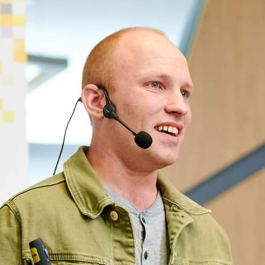
At social media app Tinder, Software Engineer Kyle Boss said that if something piques full-stack developers’ interest, they’re given the tools and independence to take that idea and bring it to life.
What role does a full stack-developer typically play at your company?
At Tinder, full-stack developers typically work with JavaScript (mainly React at the moment), HTML and CSS. However, if going deeper down the stack piques your interest, we have plenty of AWS microservices that we love to innovate and tinker with.
Our full-stack developers will undoubtedly work on large scale, impactful projects. To be able to accomplish this, our team is given the tools and independence to take an idea — whether it be from a Jira ticket to a back-of-the-napkin drawing — and bring it to life. If we have an idea to improve our build process, we have AWS sandboxes that engineers experiment with. If we want to experiment with the latest and greatest JavaScript framework, new projects come by often (yes, even greenfield ones!) and they are great opportunities to innovate.
Overall, we try to cultivate an environment that embraces each person’s strength.
Our full-stack developers will undoubtedly work on large scale, impactful projects.”
What’s an interesting project you’re currently working on?
While Tinder is a native app, it can also be used on the web at Tinder.com. This means our full-stack developers get to work on core features that are accessed by millions of members worldwide. We also have the ability to work on high-visibility, greenfield projects that support our marketing efforts.
In fact, I recently wrapped up working on a website for Tinder’s interactive video experience, Swipe Night. To keep up with the latest technology trends, the web team decided to generate the entire site, statically, using Gatsby. This gives us many benefits such as being serverless, but it also introduces some unique challenges. For example, a lot of work that is usually done on run-time is pushed to the build for static sites. This means our build times for some larger projects are rather long, so we try to reduce the amount of time it takes for the build to complete and have our changes go live to production.
That said, every line of code we write has an impact on visitors across the world, so it’s meaningful and rewarding work. Our full-stack developers are able to make great web apps in such a way that internationalization, accessibility and performance are baked into every project.
Cameo
Nina Chaubal
SOFTWARE ENGINEER

Cameo is a digital media company that enables consumers to book personalized video messages from their favorite pop-culture icons. Full-stack engineers often work on the mobile app, website and back end at the same time, Software Engineer Nina Chaubal said.
What role does a full-stack developer typically play at your company?
On the fan experience team, we take a project that impacts our fans and run through walls to make it happen. We’re working on the Cameo app, the website and our back end, often at the same time. While everyone on our team has their areas of expertise, our ability to roll up our sleeves and work on whatever part of our system is appropriate for the problem at hand makes us an effective team. Whether it’s implementing a new feature end to end or chasing a bug that spans layers of the system, full-stack engineers are our strength.
Whether it’s implementing a new feature end to end or chasing a bug that spans layers of the system, full-stack engineers are our strength.”
What’s an interesting project you’re currently working on?
I’ve been working on sharing Cameo videos to social platforms. It’s an interesting technical challenge to build and test a consistent experience across various apps a fan may share a Cameo to. My favorite part of working on this particular project is that we get to build a richer experience for fans engaging with our app while also impacting the virality of the content each of our talent makes.
ShapeShift
Software Engineer
A MEMBER OF THE COIN TEAM
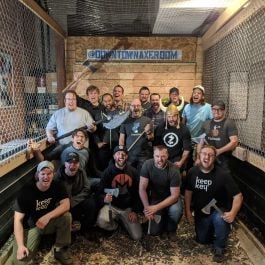
ShapeShift is a crypto-services company that helps users easily manage their digital finances. Due to the nature of the industry, most developers are anonymous (like the one featured below). However, full-stack developers do play a large role in many of the company’s development processes, working across several repositories at any given time.
What role does a full-stack developer typically play at your company?
Full-stack developers get to play a role in large slices of our processes, as well as across the entire codebase. We start each set of feature work (we call them epics) by meeting with the product team to understand the desired end-user functionality, including the UI/UX designs (user stories). Then, a squad of developers convenes to discuss the stories and break the work down into developer tasks. We discuss various design decisions so we are all on the same page at a high-level and leave the more granular implementation to the individual developer who picks up each task.
The work includes back-end services to serve data and functionality to the front end, as well as the front-end coding on both web and mobile. More often than not, we work across a number of our repositories in a given epic. It keeps things interesting and there’s always more to learn.
Full-stack developers get to play a role in large slices of our processes, as well as across the entire codebase.”
What’s an interesting project you’re currently working on?
I am working on a project to refactor the way we access blockchain data. This is a fun challenge because there isn’t an “easy way” to create a standard process for our services to query for blockchain data. At ShapeShift, we have a platform that allows users to trade between coins and tokens, where each coin or token functions a little bit differently. Tokens live on blockchains that already exist, while coins have a specific and unique blockchain that they run on.
There is nothing more satisfying than seeing a new coin or token go live on our platform. One aspect I am most proud of is the time our team dedicates to learning lessons from older implementations and then improving upon them. Our industry is innovating quickly, so we need to come up with solutions that work for us now and give us the flexibility to adapt to future needs. We are always working on how to do something better to keep ahead of the competition.
Guild Education
Jay Ockers
SENIOR SOFTWARE ENGINEERING MANAGER
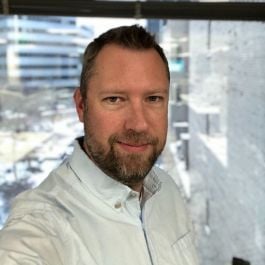
Guild is an education technology company that partners with employers to build strategy education benefits programs for employees. Senior Software Engineering Manager Jay Ockers said that even though his team supports multiple different technology stacks, everyone is encouraged to work together to make cohesive and comprehensive solutions.
What role does a full-stack developer typically play at your company?
Guild engineering deploys full-stack engineers to most of our teams to ensure they take a holistic approach to solving problems. My team supports multiple React single-page applications, a back-end Rails API, a few lambdas and various other cloud technologies. I lean on my full-stack engineers to help everyone stitch together the pieces into cohesive and comprehensive solutions. The benefit of this approach is that it allows some engineers to specialize in technologies like React or Rails and still create complete, well-designed solutions.
My team solves problems with our business and mission of unlocking opportunity through education and upskilling with America’s workforce in mind.”
What’s an interesting project you’re currently working on?
My team is working to replace our original Rails-based roles and permissions system with a modern solution that is easier for our IT organization to manage, is more secure, and most importantly, scales for our growing student population. I challenge my engineers to solve problems with our entire business and mission of unlocking opportunity through education and upskilling with America’s workforce in mind. While keeping both of those front of mind can present some challenges, it also ensures that our solutions are significantly more complete.
The greatest reward for myself and my team comes from gaining a deeper understanding of the problems that our business solves so that we can build better models that more accurately account for those challenges and, in turn, better serve the students our company supports.
Trineo
Michael Ovies
LEAD ENGINEER

Trineo is a professional services and software company that focuses on free legacy data, delivering future-proof API platforms, and developing customer and employee experiences. Lead Engineer Michael Ovies said that engineers who embrace the full stack play an important role in feature development at Trineo.
What role does a full-stack developer typically play at your company?
Understanding a feature set across the stack is a potent skill for an engineer to bring to the team. Not every engineer cares to excel across domains or should be expected to, however, those who do are incredibly useful to their team. Here at Trineo, we certainly have a mix of preferences, but those that embrace the full-stack often play an important function in feature development. These engineers often work to bridge both domains in such a way that we wind up with a much greater understanding of how all the pieces fit together. This is where their knowledge really pays off, in my opinion.
Full-stack engineers often work to bridge both domains in such a way that we wind up with a much greater understanding of how all the pieces fit together.”
What’s an interesting project you’re currently working on?
My team and I are currently working for one of our long-time clients on a compelling new piece of work that focuses on reporting. This client is in the physical advertising business, both print and digital signs, so being able to report on key measures of how their ads are performing across both practices is directly tied to their bottom line.
It’s true that PDFs and reports aren’t the sexiest things in the world, but their current solutions are over a decade old and are representative of how things worked when initially built. With this new initiative, we now have the opportunity to bring these reports into alignment with a fresher take on our customer’s brand. Doing this will consolidate multiple reports into one and streamline the entire process, from request to delivery, into something much more user-centric. As a result of these improvements, we will be driving increased value for our customer’s users along with more clearly demonstrating the value of the ads themselves — directly impacting our customer’s bottom line.
In general, I derive most of the reward in software engineering from the impact it has on the end-user.
Havenly
Steve Moody
SENIOR SOFTWARE ENGINEER

Havenly is an online interior design and home decorating platform that allows users to have as much or as little input as they want. This year, developers at Havenly created a new feature of the app that allows users to search and safe design inspiration for their own spaces, Senior Software Engineer Steve Moody said.
What role does a full-stack developer typically play at your company?
Full-stack developers do it all at Havenly — we develop, test and deploy code from inception to production. We build and maintain cloud infrastructure, evaluate and resolve bugs as they are discovered, and plan and scope user stories alongside business stakeholders.
To put this into perspective, I recently worked on a project to add Apple Pay to our iOS app, which involved an upgrade to our payments integration. This started with a user story from our product team, from which I scoped and tasked out the work. In the end, I built a new server-side integration with our payments provider, a serverless event handler service, updated existing database entities and helped develop new browser and iOS app elements.
It’s been rewarding to build a product that helps people create a delightful home environment.”
What’s an interesting project you’re currently working on?
At Havenly, our interior designers create a ton of beautifully-designed room renderings that they deliver to our customers. This year, we worked hard to build a new feature of our app that shares the best of those beautiful designs in a feed for all our users to see. Through this feature called “Explore,” users can search and save design inspiration for their own living spaces. It’s been rewarding to build a product that helps people create a delightful home environment, especially now that many of us are spending much more time there.
Fanatics
Stacie Graves
SENIOR SOFTWARE ENGINEER

Fanatics is an e-commerce company that designs, manufactures and distributes high-quality sports gear across retail channels. Senior Software Engineer Stacie Graves said that at Fanatics, engineers are encouraged to have a specific area of expertise so that they can share knowledge and resources across different parts of the project.
What role does a full-stack developer typically play at your company?
At Fanatics, full-stack engineers can work across the stack but often have a specific area of expertise. We leverage this skill set by sharing resources across different parts of our project as needed. For instance, sometimes there are challenging problems that require more effort in specific parts of our stack and we can devote additional resources when necessary to meet our goals.
At Fanatics, full-stack engineers can work across the stack but often have a specific area of expertise.”
What’s an interesting project you’re currently working on?
I am currently working on an ETL project that we’ve written in-house. I find this project both challenging and rewarding because we’re using a modern technology stack and generating our own code to support our underlying models. Code generation can be especially powerful to save time on repetitive tasks that can’t be normalized in code.
For example, our data models are rapidly changing and we’re using templates in Golang to generate the code necessary to support the usage of these models so that we don’t need to make these changes by hand in a multitude of different places. Not only does this save us time but it’s also more accurate. Code generation isn't something that I’ve had the opportunity to use often, so it keeps things really interesting.
AdAction
Clay Smith
FULL-STACK DEVELOPER

AdAction helps companies get more clicks and conversions through its app advertisements and monetization solutions. Full-Stack Developer Clay Smith said that because AdAction encompasses more than just one website, developers must be able to create a product that they can apply across the board.
What role does a full-stack developer typically play at your company?
A full-stack developer is kind of seen as a Swiss Army Knife. Whether a problem needs a DevOps solution in AWS or a custom UI tool built out from a drawing on a napkin, a developer can do it.
The application I am currently working on is the classic example of a full-stack developer. This application is user-facing and includes integrating with an API to communicate with the server and deciding what database and schema is best suited for data needs while making deployments easy through a CI/CD pipeline. The unique aspect at AdAction is that “full-stack” encompasses more than a single website, so developers here have to think, “How can I make this reusable for website X with the potential for website Y and Z to use as well?”
However, code can solve problems outside of the standard front-end and back-end idea most people think of. I recently threw a quick Google App Script together to make someone’s job a little easier by automating calendar updates through a spreadsheet.
Whether a problem needs a dev-ops solution in AWS or a custom UI tool built out from a drawing on a napkin, a developer can do it.”
What’s an interesting project you’re currently working on?
My current project is building out an interactive consumer site, as well as a platform, to spin up many similar sites in the future. This is a unique structure since it’s essentially a content delivery network and must be scalable to manage dozens of sites in the future without exponentially increasing resources and complexity. It’s challenging to learn the specific business and optimize a single application while keeping the big picture in mind as well.
It’s fun working for a small company — you have to really know how the whole tech structure works or find out quickly. If a piece is missing, you learn it and build it. As a developer, I get to constantly push my skills and learn at a rate that just is not possible at a larger company.
Narrative Science
Michael Smathers
PRINCIPAL SOFTWARE ENGINEER
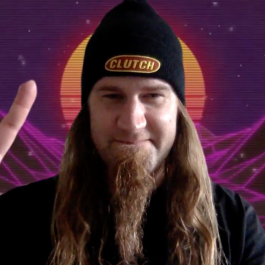
Artificial intelligence company Narrative Science helps companies better understand their consumer data and insights using “data storytelling technologies.” Michael Smathers, a principal software engineer, said that there are many opportunities for full-stack developers to move across the stack.
What role does a full-stack developer typically play at your company?
There are numerous opportunities for a full-stack developer to make a big impact on our technology. Our stack includes everything from cloud services such as Amazon Web Services and CircleCI, to Python and AsyncIOback end REST API microservices, React front ends and everything in between. Our authoring engine involves a number of more academic pursuits including designing composable parse trees and graph modeling or traversal. Building platform features often involves implementing brand new back end Async workers, status and configuration API endpoints, and Redux and React front ends, all of which can be designed and built by full-stack engineers.
Our recent work to support Tableau dashboard data sources has been perfect for a full-stack skillset. Over the course of two weeks, I extended our platform to securely store external authentication credentials, implemented data ingestion logic to query file-based Tableau data dumps and stream result sets to S3, and built out a “connection status” UI that polls data-loading endpoints to inform the end user about data ingestion progress.
Beyond this specific project, our team encourages rapid prototyping of new capabilities to explore and de-risk potential roadmap items. These are great opportunities for full-stack developers to quickly move up and down the stack with a hackathon-like mentality of sprinting towards a minimally-viable product (MVP) that will wow the team and company-wide stakeholders.
Our team encourages rapid prototyping of new capabilities to explore and de-risk potential roadmap items.”
What’s an interesting project you’re currently working on?
We’re currently building out support for Tableau dashboards as a data source for Lexio, our data storytelling platform. Unlocking this capability will greatly expand our potential user base while reducing integration time and cost at the same time. By sitting on top of Tableau, our platform can leverage an organization’s existing data pipelining infrastructure to achieve product value in minutes, rather than days of back and forth between cloud-ops and IT teams.
The challenges and learnings from this project have been numerous. The mechanics of Tableau data ingestion at scale involves orchestrating three separate APIs and libraries, including the use of a new piece of technology that required us to upgrade our build system. We rapidly prototyped a novel data loading UI, which we jokingly call “the most elaborate loading spinner ever built.” It displays portions of metadata and raw data in the browser as they become available, giving the end user insight into what’s happening under the hood. Perhaps the biggest learning from this project has been to conceptually decouple metadata and schema ingestion from ingestion of the full, raw dataset. While this happened out of necessity, we realized that this decoupling would allow for more future flexibility when pipelining new types of data sources.
Kin + Carta
Vince Hétet
FULL-STACK DEVELOPER
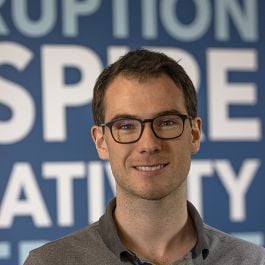
Kin + Carta offers clients three main services: software engineering, consultancy and digital marketing and branding. Full-Stack Developer Vince Hétet said that at Kin + Carta, full-stack developers have lots of opportunities to jump into new positions in order to work together as a team.
What role does a full-stack developer typically play at your company?
As a consultant, I deal with a pretty wide variety of projects, industries and tech stacks. This means that full-stack developers at Kin + Carta regularly have the opportunity to jump into back-end or front-end positions. On a recent project, we were building a web application for a client in the healthcare industry, specifically a front-end application for their employees. After a few months of development, it became clear that the back-end team needed support. Alongside a few of my teammates, we were able to provide that support immediately.
While it has its challenges, it’s been extremely rewarding to see that I can leverage my experience and quickly have an impact on my team.”
What’s an interesting project you’re currently working on?
I am working on a project to build an e-commerce web platform for farming products. When I joined the team, I was new to tech stack and most of the industry. While it has its challenges, it’s been extremely rewarding to see that I can leverage my experience and quickly have an impact on my team. I feel like I am always learning new things, which I enjoy.
Supernova
Henry Wu
FULL-STACK DEVELOPER
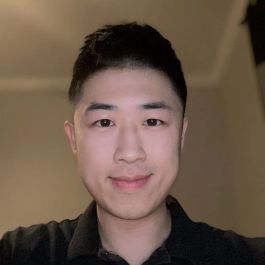
Fintech company Supernova offers a cloud-based, fully-customizable, end-to-end software solution that automates securities-based lending. Full-Stack Developer Henry Wu said that while he wears a lot of hats in his position, it’s rewarding to be able to solve any challenges that come his way.
What role does a full-stack developer typically play at your company?
A full-stack developer is responsible for communicating and analyzing user requirements, authorizing functional requirement documentation and workflows, building wireframes and interactive prototypes, and then helping implement web applications with the broader team.
Smart Analytics is a recent project at Supernova that not only relied heavily on a full-stack engineer’s ability to work on both front-end and back-end implementations, but also to build an effective communication process across internal clients. In addition, a full-stack developer needs to be a quick learner in order to get up to speed quickly and be capable of making significant contributions to projects in short order. Most importantly, they need to be effective at bringing different team members, or even teams, together to collaborate on projects and arrive at solutions together.
It’s rewarding to wear so many hats. I am the full-stack developer overseeing an entire web application at Supernova. At other companies, I might be in charge of one page or just one feature. Plus, we are growing and evolving our platform at a fast pace, which leads to many challenges for an engineer to solve — which I also find rewarding.
We are constantly learning and making our product better every day.”
What’s an interesting project you’re currently working on?
One of the projects I am currently working on is called Smart Analytics. It’s our next flagship product that provides reporting, monitoring and analysis to our customers that use our securities-based lending (SBL) technology platform for wealth lending. It enables customers to easily see all kinds of useful business intelligence analyses and reports based on a wide array of loan data. The goal is to build a powerful data platform where our customers can drill down and answer all kinds of questions with data.
This project was challenging because it is a brand new product and we had to build everything from the ground up. As a full-stack engineer, I not only had to work on the back-end implementation but also worked closely with the product manager and user experience designer on the front-end design. Being able to collaborate with different groups of people to understand the business needs while working closely with the engineers on all kinds of technical problems is quite challenging. However, it’s those challenges that make it so special and attractive to work at Supernova, and we are constantly learning and making our product better every day.
One North
Jimmy Tsao
FRONT-END ARCHITECT

One North is a full-service digital agency that helps clients solve complex problems in creative ways. Because of their abilities to work on the back or front end, full-stack developers at One North provide each project with a lot of flexibility, Front-End Architect Jimmy Tsao said.
What role does a full-stack developer typically play at your company?
Full-stack developers are highly valued at One North for their knowledge across the stack and are usually in senior roles on a project team. On a recent project, the full-stack developer on the team played a key role in architecting solutions for business requirements and led a team of front-end and back-end developers on the implementation. The full-stack developer provided the project with a lot of flexibility by being able to work on the back end or front end, depending on the needs of the project. When issues arose, the full-stack developer quickly diagnosed which layers in the stack were involved and coordinated with the corresponding developers to resolve.
I get to work with a talented team to think through and solve challenges.”
What’s an interesting project you’re currently working on?
I’m currently building a digital experience for a client using a headless CMS architecture. The approach that we’re using is new and different from how One North has traditionally built websites, so this inherently introduces a lot of interesting engineering challenges. The best part is that I get to work with a talented team to think through and solve these challenges while knowing that our solutions and decisions will have an influence on how One North approaches these types of projects moving forward.
Carminati Consulting
Michael Brower
DIRECTOR OF SOFTWARE DEVELOPMENT
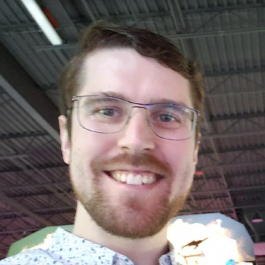
IT consulting firm Carminati Consulting provides clients unique solutions to software application development, website design, data analytics and project management. Currently, developers at Carminati are working on a software solution called Immuware, which Director of Software Development Michael Brower said is his most rewarding project yet.
What role does a full-stack developer typically play at your company?
Full-stack developers truly get to work across the stack at Carminati. From interfacing with the database through Entity Framework to implementing the business logic and massaging the data through .Net, and displaying and interacting with the data on the front end through Bootstrap and jQuery, there are opportunities to work on it all.
You don’t have to look any further than Immuware and the integration module (mentioned below). Our developers had to write the queries to read and write the external data to the Immuware database. They had to write the code to handle the logic of translating the mapping data, building a payload file and establishing the transmission frequency. Finally, they had to implement the front end in a way that was intuitive to our business analysts so that they can easily map the data.
Our integrations module has put us in a good place to meet the timeline challenge and provide excellent service to our clients.”
What’s an interesting project you’re currently working on?
We are currently working on a project to integrate our SaaS solution, Immuware, with a third-party company that will report vaccination information, including the upcoming COVID-19 vaccine, to state registries. This integration project has many technical components that are the culmination of months of development to build a custom “integration module,” as we’ve dubbed it. Our custom integration module lays out the framework for querying or writing the data, translating the data, building or reading a payload file containing the data, transmitting the data file and setting the frequency in which to transmit the data. One of the biggest challenges when integrating data is understanding the data itself, including the formats and how they are similar or different between both systems.
The state registry integration project in particular has been challenging primarily because of the aggressive deadline to have everything in place in preparation for the release of the first emergency use COVID-19 vaccines. Our integrations module has put us in a good place to meet the timeline challenge and provide excellent service to our clients. Beyond that, this project is rewarding in a way that I’ve never felt before. Not only does it feel like we are on the cutting edge of providing critical data to state registries in order to assist with the ongoing development of a vaccine, but we have set ourselves up to meet this challenge head-on with the extraordinary work our development team has done and continues to do.
RedShelf
Marielle Billig
SOFTWARE ENGINEER

Education technology company RedShelf helps make education more affordable and effective through digital course materials. Because most of the features RedShelf offers contain front- and back-end work, Software Engineer Marielle Billig said that it’s important for developers to wear many hats.
What role does a full-stack developer typically play at your company?
A full-stack engineer often wears many hats at RedShelf. Nearly every feature our team adds has an element of front- and back-end work, so it’s extremely advantageous to have an understanding of both. Design and user experience are huge aspects of front-end development and I believe that the practice of putting the user first also informs my back-end work, which leads to an improved product overall.
I love the process of seeing an idea for a product progress to an actual web page and making it come alive under my hands.”
What’s an interesting project you’re currently working on?
We’re currently working on building a suite of tools that allow our partners to manage their catalogs directly. I love the process of seeing an idea for a product progress to an actual web page and making it come alive under my hands. It’s exciting to see the things I work on “in the wild” and hear that they’re making people’s lives a little bit easier.
Topstep
Will Sanders
PLATFORM ENGINEER

Topstep is a trading platform that enables aspiring traders to learn how to manage risk, gain confidence and trade capital without putting their life savings on the line. In order to keep up with increased scalability, Platform Engineer Will Sanders said Topstep’s developers are working on a new cloud-native infrastructure.
What role does a full-stack developer typically play at your company?
Though my expertise lies more on the back-end side of things, we encourage as much ownership as possible. The shift we’re making to a new cloud-native architecture creates a lot of opportunities to establish patterns at a foundational level. And, based on an individual team member’s comfort level, there’s also plenty of opportunity for CI/CD pipelines, infrastructure as code, data modeling in both relational and NoSQL environments, APIs, back-end systems and foundational front-end patterns.
Our new upgrades will enable us to scale and continue to iterate on our product at a more rapid pace.”
We often leverage a full stack developer’s expertise across an entire project. A perfect example of this would be our data processing. We started by establishing the infrastructure using infrastructure-as-code tooling. Then, we performed data modeling for tracking the processing state and wrote all of the back-end code using Node.js and TypeScript to establish organizational patterns along the way. To bring it all together, we employed a suite of unit tests and end-to-end tests against the live test-bed infrastructure to ensure our codebase was strong and resilient against change.
Leveraging AWS Managed Services is a massive benefit to a small team like ours, hence the migration. It helps keep the complexity levels low and allows individuals to have a much more significant role across the project.
What’s an interesting project you’re currently working on?
As Topstep continues to grow, one of the biggest challenges we face is increasing scalability. Building segregated applications makes it difficult to keep pace with increasing demand. Right now, we’re laying the foundation and establishing patterns for a new cloud-native infrastructure to adopt moving forward. This will allow us to be more elastic and give every project team access to the infrastructure they need when they need it.
This project will involve moving away from a monolithic Rails web application hosted on a server and move to a distributed, event-driven architecture using AWS. We have already adopted a handful of microservices that are currently being consumed in production as well as an entirely new means to process data. These upgrades will enable us to scale and continue to iterate on our product at a more rapid pace.
Bright Health
Anh Ho
SOFTWARE ENGINEER

Working to streamline a search tool — for healthcare providers or any profession — is no simple task. At Bright Health, developers take time to consider the ramp-up associated with learning a new function and keep varying user expectations in mind. Anh Ho, a software engineer, said full-stack developers have the flexibility to contribute where necessary with the ultimate goal of creating the best product possible.
Describe a project you’re working on right now, and why you find it challenging or rewarding.
Over the course of the year, my team and I have been building a provider search tool that holistically balances ease-of-use and feature richness so the user can easily find what they are looking for. The search is used to discover providers, practices and facilities that are available to Bright Health members. This sounds simple but is actually quite challenging. Search is inherently difficult. Users have varying expectations and query differently.
I started my career in the financial and oil/gas sectors before landing in healthcare. Since then, I’ve learned a lot about its intricacies. A recurring sentiment is that finding care can often be a frustrating and stressful endeavor. It’s fulfilling knowing that I’m contributing to projects that genuinely help people.
Being full stack enables engineers to have the flexibility and agency to work on any feature that arises.’’
What role does a full-stack developer typically play at your company?
On my team, being full stack enables engineers to have the flexibility and agency to work on any feature that arises. That flexibility allows us to contribute where needed, regardless of where in the tech stack the work is, so we can build the best product possible.
Our “featured services” search result is a prime example of leveraging an engineer’s ability to work full stack. This feature required updates to the database to store services information, creating a C# API endpoint for retrieval. Being full stack, one developer was able to build the entire feature on the front end without being blocked waiting for another developer or team to complete work around a specific part of the stack.
SourceDay
Evan King
SENIOR FULL-STACK DEVELOPER

While managers at SourceDay understand that not every team member can be an expert on each aspect of the constantly evolving tech landscape, Senior Full-Stack Developer Evan King says that the projects his team works on require a deep understanding of certain technologies. The team also relies on cross-functional collaboration and an in-depth knowledge of their payments platform.
Describe a project you’re working on right now, and why you find it challenging or rewarding.
As a full-stack developer, I’ve most recently worked on SourceDay’s accounts payable automation product, which allows customers to manage supplier invoices from receipt to payment. It automatically identifies mismatches from the invoice compared to the original purchase order, including item quantity, receipts and price. Historically, such mismatches have been an industry challenge as we are pulling data from hundreds — sometimes thousands — of external sources and no two suppliers format their invoices the same way.
We are working to build back-end functionality that translates these PDFs from various formats into a normalized data set that can then be matched with purchase order data. This makes it easy for end-users to find and reconcile mismatches while automatically processing the matches for payment.
We’ve cultivated a culture of continuous learning and information-sharing.’’
What role does a full-stack developer typically play at your company?
At SourceDay, everyone on the engineering team contributes to the application in development, whether that’s architecting new features or troubleshooting back-end bugs. The projects we work on require a deep understanding of different technologies, and with the fast-paced nature of this industry, SourceDay recognizes that not everyone will have expertise in every aspect. Instead, we’ve cultivated a culture of continuous learning and information-sharing. While someone on the team might have more experience on one technology or another, we learn from each other and encourage cross-departmental mentorship.
We also work closely with the product teams to ensure collaboration between feature rollouts and functionality on the engineering side. We work together to provide our customers with the best user experience, supported by a strong platform architecture.
SecureLink
David Greene
SOFTWARE ARCHITECT

At SecureLink, leadership considers all developers to be full stack, as they touch a wide range of existing code. For example, a recent initiative that focused on reliability for unstable internet connections required the development team to add specific checksum tests to the company’s various download components. Software Architect David Greene said the updates took place across both ends of SecureLink’s connectivity software, which utilized their web API.
Describe a project you’re working on right now, and why you find it challenging or rewarding.
The core authorization model that SecureLink uses has been around for a long time, and it works well. Over the past few years, some of our larger customers have needed a more fine-grained permission model. This has led to a new feature we’re just now rolling out called Hierarchical Permissions. The core premise is that a department hierarchy exists independent of application data. Certain entities are then assigned a specific department in the hierarchy. The hierarchical permissions include VIEW_USER and EDIT_GATEKEEPER, which are linked to departments that are attached to broader locations. Consequently, a user might be able to view U.S., Canadian and French users, but only edit those in the U.S. department.
Our core challenge is designing this new hierarchical model so that we can deliver what the customer needs while minimizing risk to across-the-board changes to existing code. Suffice to say that solving hard problems is the reward in and of itself.
Suffice to say that solving hard problems is the reward in and of itself.’’
What role does a full stack developer typically play at your company?
SecureLink’s application is extremely complex and combines the use of traditional support clients (like Remote Desktop or SSH) with our own custom connectivity software. In turn, that software employs a customized and hardened Linux OS to serve an enterprise application, which uses a traditional Java web application server, which audits data. This data is then forwarded to yet more customized connectivity software. Some might see full stack and think that means database, Java, JavaScript and HTML. But at SecureLink, it’s so much more.
Expedia Group
Siobhan Burch
SENIOR SOFTWARE ENGINEER AND U.S. TECH LEAD
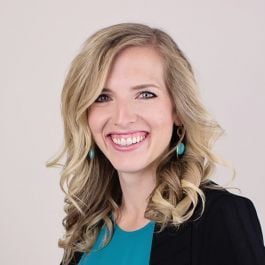
In addition to identifying missing components of existing features, full-stack developers at Expedia Group have the added responsibility of making sure the front-end and back-end developers’ designs are aligned. Senior Software Engineer and U.S. Tech Lead Siobhan Burch works on the travel company’s Experimentation Platform, meaning she researches and implements experimental methodologies like A/B tests across the business.
Describe a project you’re working on right now, and why you find it challenging or rewarding.
Earlier this year, my team merged with two other brand teams. The merger has given us the opportunity to simplify our apps, tools and libraries for all departments across Expedia Group. We’ve all had to learn more about the current brand implementations, and align with analytics and product team members. As we’ve started to realize smaller deliverables, it’s exciting to see how the complete vision is coming together. It makes me want to keep pushing to get to the next goal.
A full-stack developer needs to deeply understand how the front end works with the back-end services and databases.’’
What role does a full stack developer typically play at your company?
A full-stack developer needs to deeply understand how the front end works with the back-end services and databases. We have the added responsibility of making sure the front-end and back-end developers’ designs are aligned and feasible. We then must identify what might be missing to accomplish the story/feature.
For example, we recently developed a management tool for product teams to maintain their experiments. This tool is built in React and connects to our service layer, written in Java, which contains validations and the database access. When product team members ask us to implement a feature in the UI, a full-stack developer on our team needs to know what would be possible with data that is currently available from the service, as well as what is needed to complete the feature.
Arrive
Cory Jbara
SOFTWARE ENGINEER
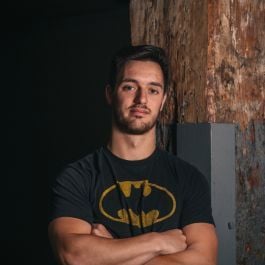
Arrive delivers users last-mile mobility solutions to navigation systems, voice platforms, websites, mobile apps and in-car dashboards, instantly connecting drivers with a network of spaces. Software Engineer Cory Jbara said that it’s pivotal for Arrive’s developers to have a well-rounded knowledge base in order to be able to pick up any project that needs work.
What role does a full-stack developer typically play at your company?
At Arrive, we have many engineers who are able to work across all parts of the stack. From back-end development on highly scalable systems to new feature design and front-end interface building, it’s pivotal that our engineers have the skills to pick up any project that needs to be done.
Because we have such a talented, versatile team, the back-end and front-end development on a feature is often completed by the same engineer, which allows us to move quickly to roll out new products and features on our platform. For example, I helped develop a lightweight API for our “Tap, Pay, Park” product, and now I am iterating on the corresponding web interface to make the checkout process much simpler for our users.
Our team has a great sense of trust in each other, and we are confident that no matter who does the work for a new feature, it will meet our high standards of excellence.
Though technology will continue to become more integrated and intertwined, it’s pivotal that we maintain our focus on the ease of use of our products.”
What’s an interesting project you’re currently working on?
I am currently working on our newest product called Tap, Pay, Park, which allows users to tap an NFC tag or scan a QR code in a parking garage and be dropped into a context-driven checkout flow, where they simply need to click a button to pay for parking.
One of the biggest challenges in technology these days is managing the complexity of integrations. Oftentimes this complexity comes at the expense of users, who have to navigate through cluttered interfaces to accomplish even the smallest task.
Though technology will continue to become more integrated and intertwined, it’s pivotal that we maintain our focus on the ease of use of our products. We must hide the inevitable complexity behind a simple interface because that’s what users want. As a company that is pioneering the bridge between the physical world and digital payments, we have a duty to serve our customers with good interfaces. Tap, Pay, Park is our way of getting back to basics, providing a frictionless solution to our customers, and we hope it will inspire other companies to follow our lead to make user experiences as simple as possible.
Name.com
Katie Wokasch
FULL-STACK ENGINEER
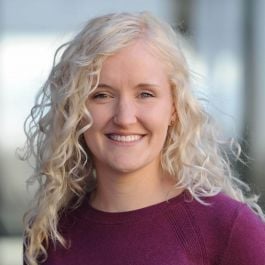
Name.com is a domain registrar that helps users get their ideas on the web. Full-Stack Engineer Katie Wokasch said that engineers at Name.com continuously rotate the type of work they do — whether it’s feature development or bug fixes.
What role does a full-stack developer typically play at your company?
One of the most interesting aspects of working on the engineering team at Name.com is that each team member has the ability to work in all parts of our code. The complex nature of our application requires a deep understanding of our stack, and each project presents new challenges and opportunities to work on different parts of our code. Each member of our team rotates through sprints where they work on either feature development or bug fixes — both of which often require full-stack investigation and development.
By working full stack, we can better understand how customers interact with the app on the front end, enabling us to better design the organization and delivery of data on the back end. This allows for more seamless communication between our back-end and front-end code and improves the overall architecture and performance of our app.
One of the most interesting aspects of working on the engineering team at Name.com is that each team member has the ability to work in all parts of our code.”
What’s an interesting project you’re currently working on?
Our engineering team is working on a project to improve usability for our global customers. This has been an interesting and complex project as these changes touch many different parts of our code. Currently, I am working to ensure that customers see their desired currency throughout the checkout process and in any communications from Name.com.
This project has been both challenging and rewarding, requiring a solid understanding of the full code stack to verify that we are collecting and displaying the correct data to our customers. It will be even more rewarding when we deliver this project and can see the positive impact it has on our customers, providing for an even better customer experience at Name.com.
MetaRouter
Doug Whitney
SENIOR UI ENGINEER
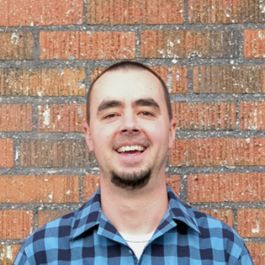
Information technology company MetaRouter provides streaming data routing solutions for companies with security and latency concerns. Doug Whitney, a senior UI engineer, said that the typical MetaRouter developer role includes hands-on development work, systems design and architecture, and managing and prioritizing workflows.
What role does a full-stack developer typically play at your company?
Although most of us on the engineering team at MetaRouter end up working across multiple layers of our tech stack, we don’t have designated full-stack developers. As a small team, we each have our own areas of focus and are expected to look at things from a product perspective, which gives developers a broad view of how all of our systems work together and encourage people to dive in wherever help is needed.
The typical developer role here includes hands-on development work, systems design and architecture, shared responsibility for managing and prioritizing workflow, as well as a large emphasis on understanding business needs and collaborating to find effective solutions.
We encourage developers to dive in wherever help is needed.”
What’s an interesting project you’re currently working on?
We’re currently building a web app that makes it easy for users to edit and manage very complex configuration files. As a greenfield project, one of the early challenges was setting up an effective monorepo architecture and the tooling necessary to separate the various app concerns into individual projects such as API layer, component library and the UI itself, while still supporting a low-friction developer experience where we can iterate quickly across projects.
One of the best parts is watching the vision for a product becoming more concrete over time and having a part in making it real.
